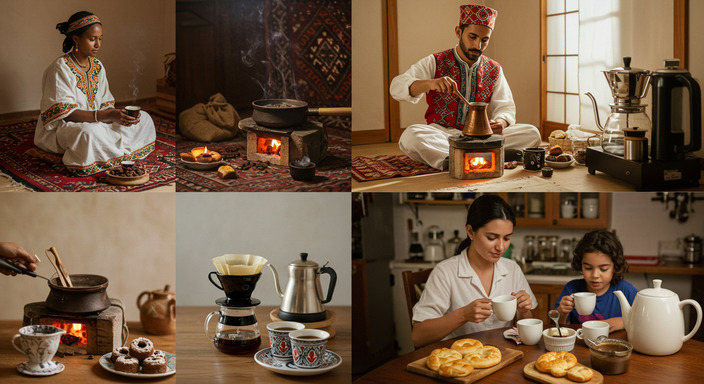Traditional Coffee Rituals and What They Teach Us About Patience
Introduction to Traditional Coffee Rituals
What Are Traditional Coffee Rituals?
Traditional coffee rituals are time-honored practices deeply rooted in cultures around the world. These rituals go beyond simply brewing and consuming coffee; they encompass a series of deliberate steps, often performed with care and intention. From the Ethiopian coffee ceremony to the Turkish method of preparing coffee on sand, these practices are a testament to the reverence societies hold for coffee as a cultural and social cornerstone.
The Cultural Significance of Coffee Rituals
These rituals are more than just a way to make coffee—they are a celebration of community, heritage, and connection. In many cultures, coffee rituals serve as a focal point for gatherings, fostering conversations and strengthening bonds. For example, in Ethiopia, the coffee ceremony is a symbol of hospitality and respect, often lasting hours and involving multiple rounds of coffee. Similarly, in the Middle East, serving coffee is a gesture of welcome and goodwill. These traditions highlight coffee’s role as a unifying force, transcending mere consumption to become a shared experience.
Patience and Mindfulness in Coffee Rituals
One of the most profound aspects of traditional coffee rituals is their ability to teach patience and mindfulness. Unlike the quick, modern approach to coffee, these rituals emphasize slowing down and savoring each step—from roasting the beans to pouring the final cup. This intentional process encourages participants to be fully present, turning coffee preparation into a meditative practice. By engaging in these rituals, we are reminded to appreciate the journey as much as the destination, fostering a deeper connection to the beverage and the moment itself.
The Art of Slow Brewing: Turkish Coffee
The Process of Making Turkish Coffee
Turkish coffee is a centuries-old tradition that embodies the essence of patience and precision. The process begins with finely ground coffee beans, ground to a powder-like consistency, finer than espresso. The coffee is then combined with cold water and sugar (optional) in a special pot called a cezve or ibrik. The mixture is gently stirred to ensure the coffee grounds are evenly distributed. Unlike other brewing methods, Turkish coffee is not filtered; instead, it is slowly heated over low heat, allowing the grounds to settle naturally.
Patience and Perfect Extraction
The key to brewing the perfect cup of Turkish coffee lies in its slow extraction. The coffee must be heated gradually, avoiding boiling, which would ruin the delicate flavors. As the coffee warms, a layer of foam, known as kaymak, begins to form on the surface. This foam is a hallmark of well-brewed Turkish coffee and requires careful attention. The cezve is removed from the heat just before boiling, and the foam is spooned into the serving cups. The process is repeated until the coffee is poured, ensuring a rich, velvety texture and full-bodied flavor.
The Role of Time and Precision
Brewing Turkish coffee is not a hurried process. Each step demands patience and precision, from grinding the beans to controlling the heat. The slow brewing method allows the coffee to fully develop its complex flavors, creating a cup that is both intense and aromatic. This ritual teaches us the value of slowing down and savoring the moment, a lesson that resonates deeply in today’s fast-paced world.
Ethiopian Coffee Ceremony: A Social and Meditative Practice
The Steps of the Ethiopian Coffee Ceremony
The Ethiopian coffee ceremony is a time-honored tradition that transforms the simple act of brewing coffee into a ritual of connection and mindfulness. The process begins with the host, usually a woman, meticulously preparing the space by spreading fresh grass or flowers on the floor, symbolizing abundance and hospitality. The steps unfold as follows:
- Cleaning the green coffee beans and roasting them in a pan over open flames, filling the air with an aromatic smokiness.
- Grinding the roasted beans using a mortar and pestle, creating a coarse coffee powder.
- Brewing the coffee in a traditional clay pot called a jebena, allowing it to steep slowly over the fire.
- Serving the coffee in small cups, typically in three rounds: abol (the first and strongest brew), tona (the second round), and baraka (the final, milder brew).
Each step is performed with care and intention, turning the preparation into a performance that engages all the senses.
Fostering Connection and Attentiveness Through Patience
The Ethiopian coffee ceremony is not just about the coffee; it’s a social and meditative practice that strengthens bonds and cultivates patience. The slow, deliberate process invites participants to pause, engage, and savor the moment. Here’s how it fosters connection:
- Shared Time: The ceremony can last for hours, providing a dedicated space for conversation and storytelling.
- Participation: Guests are often invited to partake in the process, whether by grinding the beans or simply observing the brewing steps, creating a sense of communal involvement.
- Attentiveness: The ritualistic nature of the ceremony encourages mindfulness, as participants focus on the aromas, flavors, and textures of the coffee.
This practice teaches us that patience is not just about waiting but about appreciating the journey. It’s a reminder that the act of sharing coffee can be as meaningful as the brew itself.
Japanese Siphon Brewing: Precision and Mastery
Among the world’s most captivating coffee rituals, Japanese siphon brewing stands out for its theatrical presentation and unwavering focus on balance. This method, also known as vacuum pot brewing, melds science and artistry—demanding patience, precision, and a deep appreciation for subtlety in every cup.
The Siphon Brewing Method
A siphon brewer consists of two glass chambers: an upper vessel for coffee grounds and a lower one for water, connected by a filter. Here’s how it unfolds:
- Heating the water: The lower chamber is heated, creating vapor pressure that forces water upward into the top vessel.
- Blooming the coffee: Once the water reaches the top, finely ground coffee is added and gently stirred, allowing gases to escape and flavors to develop.
- Controlled extraction: After steeping (typically 1-2 minutes), heat is removed, causing the brewed coffee to filter back down into the lower chamber.
The result? A remarkably clean, nuanced cup—bright yet balanced, with flavors that unfold layer by layer.
The Role of Patience in Clarity
Siphon brewing isn’t hurried. From maintaining consistent heat to timing each stir just right, every step is deliberate. Here’s what patience teaches us:
- Temperature control: Too much heat risks over-extraction; too little stalls the process. A steady hand ensures uniform flavor extraction.
- Grind precision: Fine grounds (ideal for siphon brewing) need exact timing—steep too long, and bitterness creeps in.
- Observation: Watching the coffee’s movement—how it bubbles, steeps, and filters—reveals the brewer’s mastery over variables.
“The siphon is a dance between fire and time. Rush it, and the flavors collapse; honor the timing, and they sing.” — Kōhi Masters Journal
Balance as a Reward
For those willing to embrace its measured pace, siphon brewing yields an ethereal clarity. Acidity, body, and aroma harmonize, offering a textbook example of how patience shapes flavor. Whether you’re a home brewer or a barista refining technique, this ritual underscores one truth: great coffee isn’t just made—it’s composed.
Lessons in Patience for Modern Coffee Lovers
Comparing Traditional and Modern Brewing Techniques
Traditional coffee brewing methods, such as the Turkish ibrik, Ethiopian jebena, or pour-over Chemex, demand time, attention, and a deliberate process. These methods were designed to slow down the brewing experience, allowing for a deeper connection with the ritual and the final product. In contrast, modern techniques like espresso machines or pod-based systems prioritize speed and convenience. While these innovations have made coffee more accessible, they often sacrifice the artistry and mindfulness inherent in traditional practices.
For example, a pour-over requires precise water temperature, controlled pouring, and a wait time that allows the coffee to bloom and extract properly. This process not only enhances flavor but also encourages the brewer to be present and patient. On the other hand, an espresso machine can produce a shot in under 30 seconds, but the experience of crafting it—though still skillful—lacks the same meditative quality.
How Patience Enhances Coffee Quality Today
Incorporating patience into modern coffee brewing can significantly elevate the quality and enjoyment of your cup. Here’s how:
- Better Extraction: Allowing coffee grounds to bloom and extract fully—whether in a French press or a pour-over—brings out nuanced flavors and aromas that might otherwise be missed.
- Mindful Preparation: Taking the time to measure, grind, and brew with care ensures consistency and highlights the unique characteristics of the beans.
- Appreciation of the Process: Slowing down turns coffee brewing into a ritual, fostering a deeper appreciation for the craft and the final product.
Even with modern tools, such as automatic drip machines or single-serve brewers, a touch of patience can make a difference. For instance, pre-wetting the filter, waiting for the water to reach the optimal temperature, or simply savoring the aroma as the coffee brews can transform a mundane task into a moment of mindfulness.
By blending the patience of traditional methods with the efficiency of modern techniques, coffee lovers can create a balance that honors both the history and innovation of coffee culture. This approach not only improves the quality of the brew but also enriches the overall experience, making each cup a moment to savor and enjoy.
Practical Tips for Incorporating Patience into Your Coffee Routine
Slow Down the Brewing Process
One of the simplest ways to cultivate patience is by slowing down the brewing process. Instead of rushing to your daily cup, take the time to savor each step. For example:
- Use a manual brewing method like pour-over or French press, which requires you to be actively involved in the process.
- Grind your coffee beans just before brewing to experience the freshest aroma and flavor.
- Pay attention to the water temperature, ensuring it’s between 195°F and 205°F for optimal extraction.
Practice Mindfulness While Brewing
Mindfulness is a powerful tool for fostering patience. As you prepare your coffee, focus on the present moment. Here’s how:
- Observe the texture and aroma of the coffee grounds as you measure them out.
- Listen to the sound of the water as it pours over the grounds, creating a soothing rhythm.
- Take a moment to inhale deeply and appreciate the rich, complex scents that fill the air.
Appreciate the Details
Each step of the coffee-making process offers an opportunity for appreciation. By paying attention to the details, you’ll develop a deeper connection to your brew:
- Notice the color and consistency of the coffee as it brews, watching it transform from a light stream to a deep, inviting hue.
- Take your first sip slowly, allowing the flavors to unfold on your palate.
- Reflect on the journey of the coffee beans, from farm to cup, and the effort that went into creating this moment.
Create a Ritual Around Your Coffee
Rituals can transform a routine into something meaningful. Consider establishing a coffee ritual that encourages patience and mindfulness:
- Set aside a specific time each day for your coffee routine, free from distractions.
- Use your favorite coffee tools, like a cherished mug or a beautifully crafted coffee pot, to enhance the experience.
- Pair your coffee with a moment of quiet reflection or a gratitude practice to start your day with intention.
Conclusion: Embracing the Wisdom of Traditional Coffee Rituals
The Essence of Patience in Coffee Culture
Traditional coffee rituals, whether it’s the meticulous Ethiopian coffee ceremony or the slow pour-over method, teach us a profound lesson: patience is key to unlocking the full potential of coffee. These practices remind us to slow down, appreciate the process, and savor the moment. In a world that often prioritizes speed and convenience, taking the time to engage in these rituals can be a grounding and enriching experience.
By embracing patience, we not only enhance the flavor of our coffee but also cultivate a deeper connection to its origins and the people who grow it. This mindful approach transforms a simple act of brewing into a meaningful ritual that nourishes both body and soul.
Inspiration to Explore and Adopt
If you’re new to traditional coffee practices, there’s no better time to start exploring. Begin with small steps—perhaps by experimenting with a manual brewing method like the French press or by learning about the cultural significance of coffee in different parts of the world. Each step you take will deepen your appreciation for the art and science of coffee making.
Here are a few ways to get started:
- Invest in quality beans and grind them fresh before brewing.
- Experiment with different brewing techniques to discover your preferred method.
- Learn about the origins of your coffee and the traditions associated with it.
- Share your coffee experiences with friends or fellow enthusiasts to foster community.
The Timeless Value of Coffee Rituals
Traditional coffee rituals are more than just methods of preparation—they are a celebration of culture, craftsmanship, and connection. By adopting these practices, you’re not just making coffee; you’re participating in a timeless tradition that has brought people together for centuries.
So, the next time you brew a cup, take a moment to slow down, reflect, and appreciate the journey that brought those beans to your cup. In doing so, you’ll discover that the true essence of coffee lies not just in its flavor, but in the patience and mindfulness it inspires.
FAQ
- Why is patience important in coffee brewing?
- Patience allows for proper extraction of flavors, ensuring a balanced and delicious cup of coffee. It also encourages mindfulness and appreciation for the process.
- What’s the best way to start incorporating traditional coffee rituals?
- Begin with simple brewing methods like a pour-over or French press, and take the time to learn about the cultural significance behind your coffee.
- Can traditional coffee rituals improve my coffee experience?
- Absolutely! These rituals enhance not only the flavor but also your connection to the coffee-making process, making it a more enriching and enjoyable experience.














Post Comment